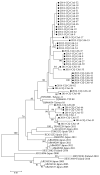Clinical and Etiological Characteristics of Atypical Hand-Foot-and-Mouth Disease in Children from Chongqing, China: A Retrospective Study
- PMID: 26693489
- PMCID: PMC4674665
- DOI: 10.1155/2015/802046
Clinical and Etiological Characteristics of Atypical Hand-Foot-and-Mouth Disease in Children from Chongqing, China: A Retrospective Study
Abstract
Background: Hand-foot-and-mouth disease (HFMD) is a disease that had similar manifestations to chickenpox, impetigo, and measles, which is easy to misdiagnose and subsequently causes delayed therapy and subsequent epidemic. To date, no study has been conducted to report the clinical and epidemiological characteristics of atypical HFMD.
Methods: 64 children with atypical HFMD out of 887 HFMD children were recruited, stool was collected, and viral VP1 was detected.
Results: The atypical HFMD accounted for 7.2% of total HFMD in the same period (64/887) and there were two peaks in its prevalence in nonepidemic seasons. Ten children (15.6%) had manifestations of neurologic involvement, of whom 4 (6.3%) were diagnosed with severe HFMD and 1 with critically severe HFMD, but all recovered smoothly. Onychomadesis and desquamation were found in 14 patients (21.9%) and 15 patients (23.4%), respectively. The most common pathogen was coxsackievirus A6 (CV-A6) which accounted for 67.2%, followed by nontypable enterovirus (26.6%), enterovirus 71 (EV-A71) (4.7%), and coxsackievirus A16 (A16) (1.5%).
Conclusions: Atypical HFMD has seasonal prevalence. The manifestations of neurologic involvement in atypical HFMD are mild and usually have a good prognosis. CV-A6 is a major pathogen causing atypical HFMD, but not a major pathogen in Chongqing, China.
Figures




Similar articles
-
Epidemiologic and etiologic characteristics of hand, foot, and mouth disease in Chongqing, China between 2010 and 2013.J Med Virol. 2016 Mar;88(3):408-16. doi: 10.1002/jmv.24349. Epub 2015 Nov 9. J Med Virol. 2016. PMID: 26255857
-
Molecular epidemiology of enterovirus 71, coxsackievirus A16 and A6 associated with hand, foot and mouth disease in Spain.Clin Microbiol Infect. 2014 Mar;20(3):O150-6. doi: 10.1111/1469-0691.12361. Epub 2013 Sep 14. Clin Microbiol Infect. 2014. PMID: 24033818
-
[The Epidemiology and Etiology Characteristics of Hand-foot-mouth Disease in Chongqing, China,2014~2015].Bing Du Xue Bao. 2016 Nov;32(6):707-12. Bing Du Xue Bao. 2016. PMID: 30004201 Chinese.
-
Atypical hand-foot-mouth disease in Belém, Amazon region, northern Brazil, with detection of coxsackievirus A6.J Clin Virol. 2020 May;126:104307. doi: 10.1016/j.jcv.2020.104307. Epub 2020 Mar 6. J Clin Virol. 2020. PMID: 32302950 Review.
-
[Prevalence and Analyses of the Changing Etiology of Hand, Foot and Mouth Disease in China].Bing Du Xue Bao. 2015 Sep;31(5):554-9. Bing Du Xue Bao. 2015. PMID: 26738295 Review. Chinese.
Cited by
-
Epidemiological Characteristics and Spatial-Temporal Distribution of Hand, Foot, and Mouth Disease in Chongqing, China, 2009-2016.Int J Environ Res Public Health. 2018 Feb 5;15(2):270. doi: 10.3390/ijerph15020270. Int J Environ Res Public Health. 2018. PMID: 29401726 Free PMC article.
-
Onychomadesis in a 9-month-old boy with hand-foot-mouth disease.Int J Emerg Med. 2017 Aug 14;10(1):26. doi: 10.1186/s12245-017-0152-9. Int J Emerg Med. 2017. PMID: 28808990 Free PMC article.
-
Molecular strategy for the direct detection and identification of human enteroviruses in clinical specimens associated with hand, foot and mouth disease.PLoS One. 2020 Nov 9;15(11):e0241614. doi: 10.1371/journal.pone.0241614. eCollection 2020. PLoS One. 2020. PMID: 33166321 Free PMC article.
-
Clinical characteristics of 68 children with atypical hand, foot, and mouth disease caused by coxsackievirus A6: a single-center retrospective analysis.Transl Pediatr. 2022 Sep;11(9):1502-1509. doi: 10.21037/tp-22-352. Transl Pediatr. 2022. PMID: 36247893 Free PMC article.
-
Onychomadesis after hand-foot-and-mouth disease.CMAJ. 2017 Feb 21;189(7):E279. doi: 10.1503/cmaj.160388. CMAJ. 2017. PMID: 28246241 Free PMC article. No abstract available.
References
-
- Tan X. J., Xu W. B. Molecular epidemiological research on enterovirus 71. Chinese Journal of Vaccines and Immunization. 2008;4:361–367.
-
- He S.-J., Han J.-F., Ding X.-X., Wang Y.-D., Qin C.-F. Characterization of enterovirus 71 and coxsackievirus A16 isolated in hand, foot, and mouth disease patients in Guangdong, 2010. International Journal of Infectious Diseases. 2013;17(11):e1025–e1030. doi: 10.1016/j.ijid.2013.04.003. - DOI - PubMed
-
- He Y.-Q., Chen L., Xu W.-B., et al. Emergence, circulation, and spatiotemporal phylogenetic analysis of coxsackievirus A6- and coxsackievirus A10-associated hand, foot, and mouth disease infections from 2008 to 2012 in Shenzhen, China. Journal of Clinical Microbiology. 2013;51(11):3560–3566. doi: 10.1128/jcm.01231-13. - DOI - PMC - PubMed
MeSH terms
Substances
LinkOut - more resources
Full Text Sources
Other Literature Sources

